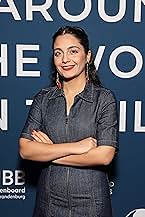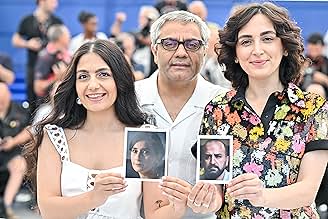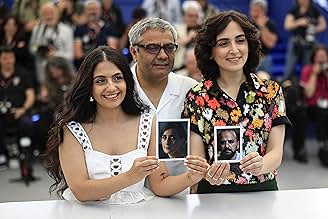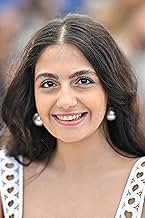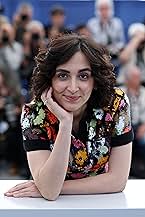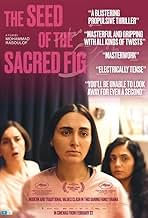An investigating judge struggles with paranoia amid political unrest in Tehran caused by the death of a young woman. When his gun goes missing, he suspects his wife and daughters, imposing h... Read allAn investigating judge struggles with paranoia amid political unrest in Tehran caused by the death of a young woman. When his gun goes missing, he suspects his wife and daughters, imposing harsh measures that fray family ties.An investigating judge struggles with paranoia amid political unrest in Tehran caused by the death of a young woman. When his gun goes missing, he suspects his wife and daughters, imposing harsh measures that fray family ties.
- Nominated for 1 Oscar
- 36 wins & 71 nominations total
- Director
- Writer
- All cast & crew
- Production, box office & more at IMDbPro
Featured reviews
To better understand the concept behind the film, this might help, learn where the name of the film comes from:
There are plants known as "strangler figs" that exhibit strange behavior. Strangler figs (genus *Ficus*) begin their life as seeds deposited on the branches of a host tree, typically by birds or other animals. The seeds germinate and send down roots that eventually reach the ground. As the roots grow and thicken, they encircle the host tree, creating a lattice-like structure.
Over time, the strangler fig's roots and branches grow larger and more robust, competing with the host tree for sunlight and nutrients. Eventually, the fig's growth can become so extensive that it constricts the host tree's trunk, restricting its ability to transport water and nutrients. This process can lead to the host tree's death, effectively allowing the strangler fig to take over the space and resources previously used by the host.
The strangler fig does not immediately kill the host tree but rather slowly overcomes it through a combination of physical encasement and competition for resources. This fascinating but destructive relationship highlights a unique strategy in the plant kingdom for survival and growth.
Over time, the strangler fig's roots and branches grow larger and more robust, competing with the host tree for sunlight and nutrients. Eventually, the fig's growth can become so extensive that it constricts the host tree's trunk, restricting its ability to transport water and nutrients. This process can lead to the host tree's death, effectively allowing the strangler fig to take over the space and resources previously used by the host.
The strangler fig does not immediately kill the host tree but rather slowly overcomes it through a combination of physical encasement and competition for resources. This fascinating but destructive relationship highlights a unique strategy in the plant kingdom for survival and growth.
The movie "The Seed of the Sacred Fig" is a political thriller centered on Iman, who is searching for a promotion in Tehran's judicial system. As he ascends in his career, he is torn between personal and professional conflicts, facing moral dilemmas within his family amid the upheaval of the 2022-2023 Iran protests.
The movie is captivating for its portrayal of the clash between an archaic, sexist, and oppressive government driven by religious ideals and the freedom of expression, culture, and modern values embraced by the younger generation. This duality extends into the family dynamic, where personal beliefs collide with political pressures, creating a powerful internal conflict.
Director and writer Mohammad Rasoulof delivers an emotional movie by blending real footage of student protests following the death of Mahsa Amini in 2022.
Another standout achievement is the title The Seed of the Sacred Fig, which perfectly captures and summarizes the essence of the movie. It's a perfect and beautiful choice that sums up the story beautifully.
The movie is captivating for its portrayal of the clash between an archaic, sexist, and oppressive government driven by religious ideals and the freedom of expression, culture, and modern values embraced by the younger generation. This duality extends into the family dynamic, where personal beliefs collide with political pressures, creating a powerful internal conflict.
Director and writer Mohammad Rasoulof delivers an emotional movie by blending real footage of student protests following the death of Mahsa Amini in 2022.
Another standout achievement is the title The Seed of the Sacred Fig, which perfectly captures and summarizes the essence of the movie. It's a perfect and beautiful choice that sums up the story beautifully.
A provocative & politically charged drama that also serves as a scathing critique of oppressive rule through the devastating account of a family's unraveling, The Seed of the Sacred Fig is an increasingly incendiary story that takes its time to acquaint us with the family dynamics before seeds of paranoia & mistrust take root in the household and turn the whole thing into a familial nightmare.
Written, co-produced & directed by Mohammad Rasoulof, the main incident that sets the plot into motion takes place over an hour into the picture but in that time, it does familiarise us with the volatile situation & civil unrest taking place outside the house that complicates things a lot more within the household. Rasoulof is patient in his approach and provides ample space for the characters to breathe.
The first half covers the clash in ideology & perspective that unfolds between the ladies of the house over the real-world riots & protests taking place outside their apartment, the footage of which is interspersed within the narrative. The film is expertly shot but the narration is rather clunky and only held together by strong performances from the cast. The runtime is also often felt, and the final act overstays its welcome.
Overall, The Seed of the Sacred Fig is a bold, brave & audacious effort from Rasoulof who risks his own life & puts everything on the line to deliver a scorching indictment that's timely & urgent in more ways than one. The slow-burn pace makes the length all the more daunting despite the premise being interesting on paper and the film as a whole needed to be more tightly-knitted to make its powerful message heard with thunderous clarity.
Written, co-produced & directed by Mohammad Rasoulof, the main incident that sets the plot into motion takes place over an hour into the picture but in that time, it does familiarise us with the volatile situation & civil unrest taking place outside the house that complicates things a lot more within the household. Rasoulof is patient in his approach and provides ample space for the characters to breathe.
The first half covers the clash in ideology & perspective that unfolds between the ladies of the house over the real-world riots & protests taking place outside their apartment, the footage of which is interspersed within the narrative. The film is expertly shot but the narration is rather clunky and only held together by strong performances from the cast. The runtime is also often felt, and the final act overstays its welcome.
Overall, The Seed of the Sacred Fig is a bold, brave & audacious effort from Rasoulof who risks his own life & puts everything on the line to deliver a scorching indictment that's timely & urgent in more ways than one. The slow-burn pace makes the length all the more daunting despite the premise being interesting on paper and the film as a whole needed to be more tightly-knitted to make its powerful message heard with thunderous clarity.
Tonight, I watched the film "The Fig Tree of Temples" and I have to say, it was one of the most beautiful and impactful cinematic experiences I've ever had. What made this film resonate with me so deeply wasn't just its strong and artistic storytelling, but the fact that every scene felt so realistic and connected to my personal experiences. It was as if every moment of the film reminded me of the tough and tense period we all went through.
The film beautifully and profoundly touches on the Mahsa Amini revolution and the social and political crises of that time, a period in which I personally participated and witnessed days filled with hardship and uncertainty. The story of the two girls in this context felt like a symbol for millions of Iranians who lived through those moments. I saw myself in those two characters, and this deep empathy gave me an opportunity to understand the emotions and struggles of that era.
The film was emotionally overwhelming, and each scene reminded me of how we all lived through those days, filled with both pain and hope. For me, this film is not just a remarkable piece of art, but also a reminder of a painful and crucial chapter in modern Iranian history.
If you're looking for a film that, in its beauty, also brings to light the harsh and painful truths of our society, "The Fig Tree of Temples" is an exceptional choice.
The film beautifully and profoundly touches on the Mahsa Amini revolution and the social and political crises of that time, a period in which I personally participated and witnessed days filled with hardship and uncertainty. The story of the two girls in this context felt like a symbol for millions of Iranians who lived through those moments. I saw myself in those two characters, and this deep empathy gave me an opportunity to understand the emotions and struggles of that era.
The film was emotionally overwhelming, and each scene reminded me of how we all lived through those days, filled with both pain and hope. For me, this film is not just a remarkable piece of art, but also a reminder of a painful and crucial chapter in modern Iranian history.
If you're looking for a film that, in its beauty, also brings to light the harsh and painful truths of our society, "The Fig Tree of Temples" is an exceptional choice.
The seed of the sacred fig is the first relevant, powerful film about the Iranian rebelion that took place in 2022. The Woman, Life, Freedom's movement was born right after the arrest and death of Jina Mahsa Amini, a student that did nothing but remove her veil. The director takes us down to a family of an Iranian judge (working for the State and the Mollah 's regime) who is about to receive a promotion that is supposed to change his life right at the moment the 2022 revolution starts. We spectators somehow live this key period of Iran through the eyes of this middle class family which is about to upgrade its living conditions. We are emerged in their every day life until the gun of the father (the judge) disapears or gets stolen inside their home.
The film features a fantastic script, wonderful actors and images of an unknown Iran. You can see Iran like we can rarely see it, with its modernity, its rich history and ancient monuments, its poverty as well as its drawbacks. Like in many Iranian films, the spectator is plunged into complex situations with ethical questions which oblige to choose between moral, personal values and loyalty to the regime: Shall I wear this veil or another (less provokative one) ? Should I go the university despite of the strikes ? Shoulld I ask a favor to my neighbor and take the risk of revealing my family's problems? The ethical questions are everywehre, and they are direct consequences of the heavy oppressive regime that has ruled Iran for now decades. All these questions are faced with dignity and sense of duty by the characters , with sometimes even loyalty towards a regime who could not care less about its people. Through these situations are revealed the lack of freedom, the oprression over women, the complicity of those who take profit of this regime and of course the brutality of a regime condemned to sacrifice its own people in order to survive.
The latter will be perfectly depicted through the fate of the father willing to do his job respectfully but obliged to corrupt himself and sacrifice his people in order to survive to this revolution no matter how painful it is.
I particularly enjoyed the insight into the Iranian middle class. Being able to see and imagine what is an every day life for women in Iran is difficult to figure from the Western World. The more the film lenghts the better it gets as you can clearly see the impasse into which the country has plunged, and with it its inhabitants (and in this case this family) condemned to find a guilty among them.
Little by little, we can spot the seeds of discord germinating in this family, into the society, among students, and throughout the world thanks to social networks. That's the other revelation of this film. Social network is the key; that's the tool through which the song Baraye resonates, as well as images of police violence are spread, proofs of the oppression are accumulated, they are the hopes of Iran. The regime can no longer hide behind outrageous lies, the seeds of rebellion are now spread everywhere and the complice of the regime can no longer hide.
A promising outcry and a promising motto for the future Iranian society: Woman, Life, Freedom that we hope, will eventually change Iran for good.
The film features a fantastic script, wonderful actors and images of an unknown Iran. You can see Iran like we can rarely see it, with its modernity, its rich history and ancient monuments, its poverty as well as its drawbacks. Like in many Iranian films, the spectator is plunged into complex situations with ethical questions which oblige to choose between moral, personal values and loyalty to the regime: Shall I wear this veil or another (less provokative one) ? Should I go the university despite of the strikes ? Shoulld I ask a favor to my neighbor and take the risk of revealing my family's problems? The ethical questions are everywehre, and they are direct consequences of the heavy oppressive regime that has ruled Iran for now decades. All these questions are faced with dignity and sense of duty by the characters , with sometimes even loyalty towards a regime who could not care less about its people. Through these situations are revealed the lack of freedom, the oprression over women, the complicity of those who take profit of this regime and of course the brutality of a regime condemned to sacrifice its own people in order to survive.
The latter will be perfectly depicted through the fate of the father willing to do his job respectfully but obliged to corrupt himself and sacrifice his people in order to survive to this revolution no matter how painful it is.
I particularly enjoyed the insight into the Iranian middle class. Being able to see and imagine what is an every day life for women in Iran is difficult to figure from the Western World. The more the film lenghts the better it gets as you can clearly see the impasse into which the country has plunged, and with it its inhabitants (and in this case this family) condemned to find a guilty among them.
Little by little, we can spot the seeds of discord germinating in this family, into the society, among students, and throughout the world thanks to social networks. That's the other revelation of this film. Social network is the key; that's the tool through which the song Baraye resonates, as well as images of police violence are spread, proofs of the oppression are accumulated, they are the hopes of Iran. The regime can no longer hide behind outrageous lies, the seeds of rebellion are now spread everywhere and the complice of the regime can no longer hide.
A promising outcry and a promising motto for the future Iranian society: Woman, Life, Freedom that we hope, will eventually change Iran for good.
Did you know
- TriviaDirector Mohammad Rasoulof was originally scheduled to take part in the 2023 Cannes Film Festival as a jury member of the Un Certain Regard section. However, he was arrested in July 2022 after criticising the government's crackdown on protestors in the southwestern city of Abadan in Iran over deadly building collapse. On May 8, 2024, Rasouloff's lawyer announced that he has been sentenced to eight years in prison as well as flogging, a fine and confiscation of his property. On May 12, 2024, Rasouloff announced that he managed to flee Iran and was staying at an undisclosed location in Europe. On May 24, 2024, Rasouloff attended the film's premiere in Cannes and on the red carpet he held up photos of two of the film's actors, Soheila Golestani and Missagh Zareh.
- Crazy creditsOpening credits: "Ficus Religiosa is a tree with an unusual life cycle. It seeds, contained in bird droppings, fall on other trees. Aerial roots spring up and grow down to the floor. Then, the branches wrap around the host tree and strangle it. Finally, the sacred fig stands on its own."
- ConnectionsFeatured in 82nd Golden Globe Awards (2025)
Details
- Release date
- Countries of origin
- Language
- Also known as
- The Seed of the Sacred Fig
- Filming locations
- Production companies
- See more company credits at IMDbPro
Box office
- Gross US & Canada
- $860,139
- Opening weekend US & Canada
- $35,230
- Dec 1, 2024
- Gross worldwide
- $6,589,303
- Runtime2 hours 47 minutes
- Color
- Sound mix
- Aspect ratio
- 2.35 : 1
Contribute to this page
Suggest an edit or add missing content

Top Gap
What is the Canadian French language plot outline for Les Graines du figuier sauvage (2024)?
Answer


